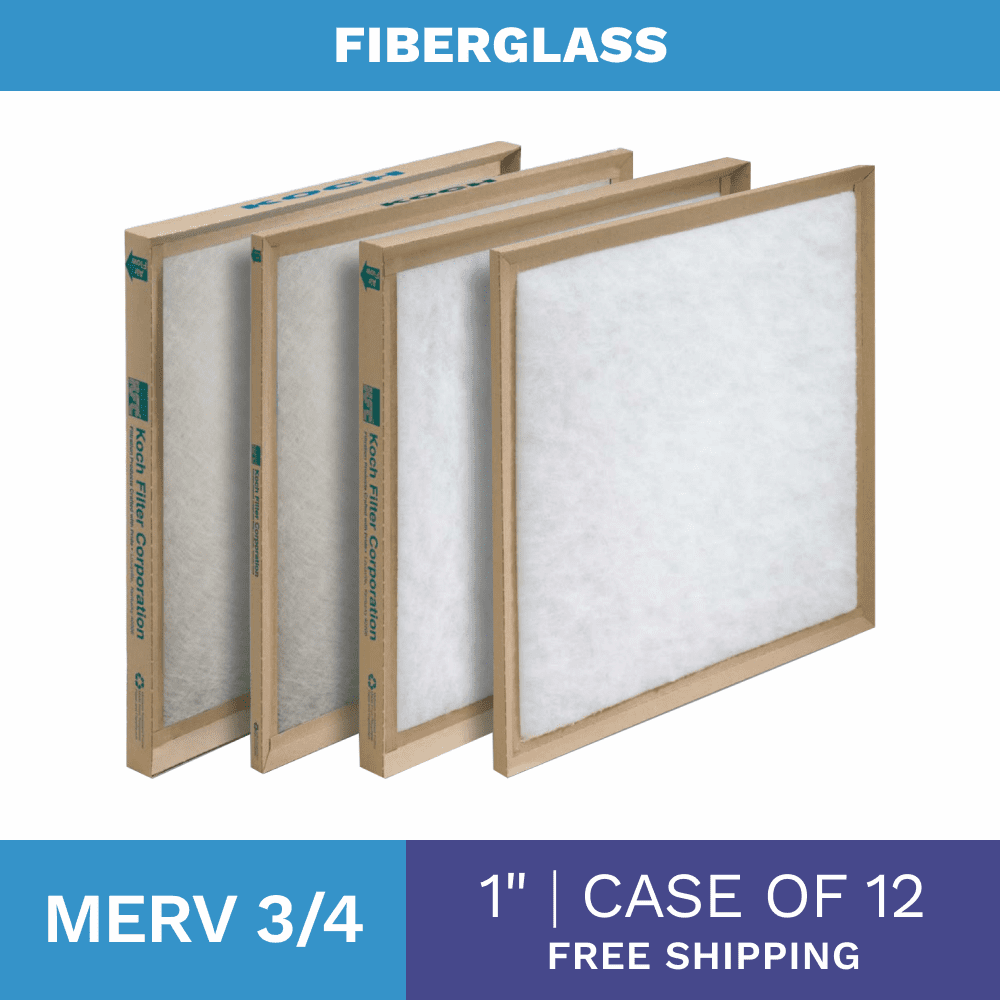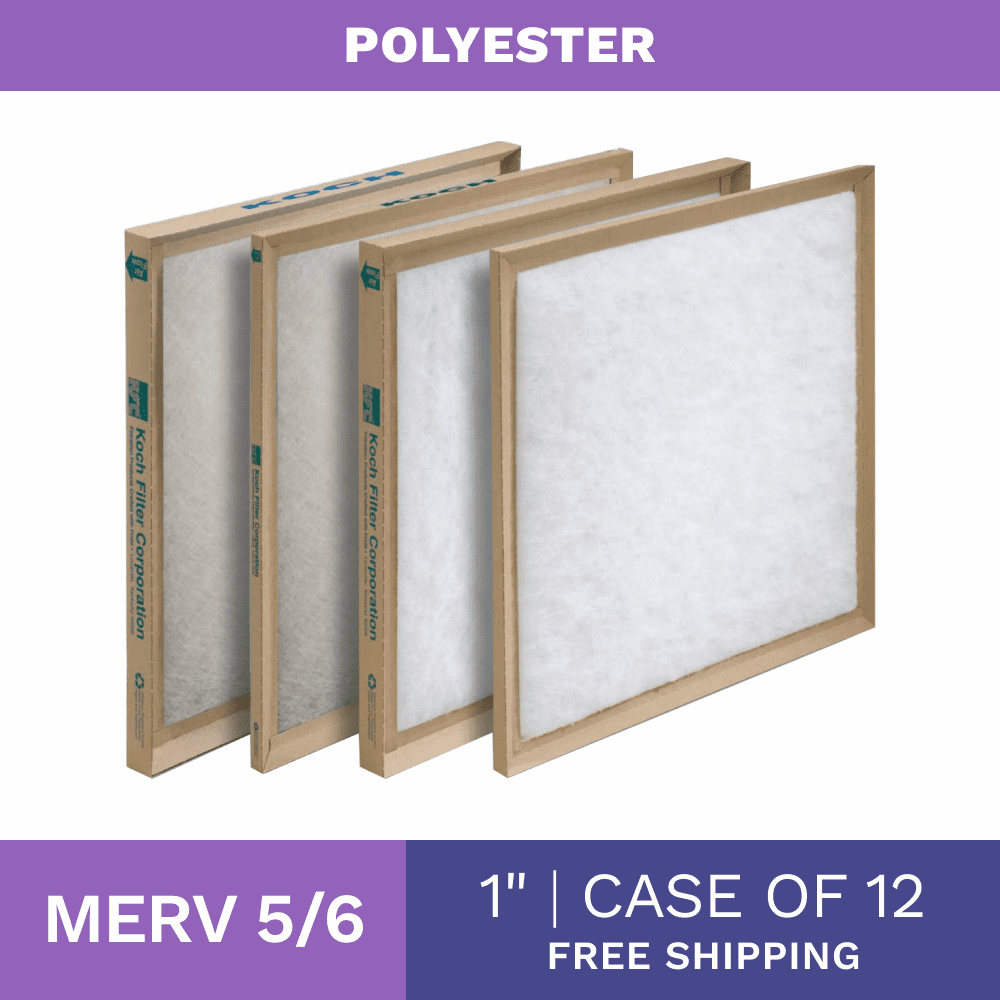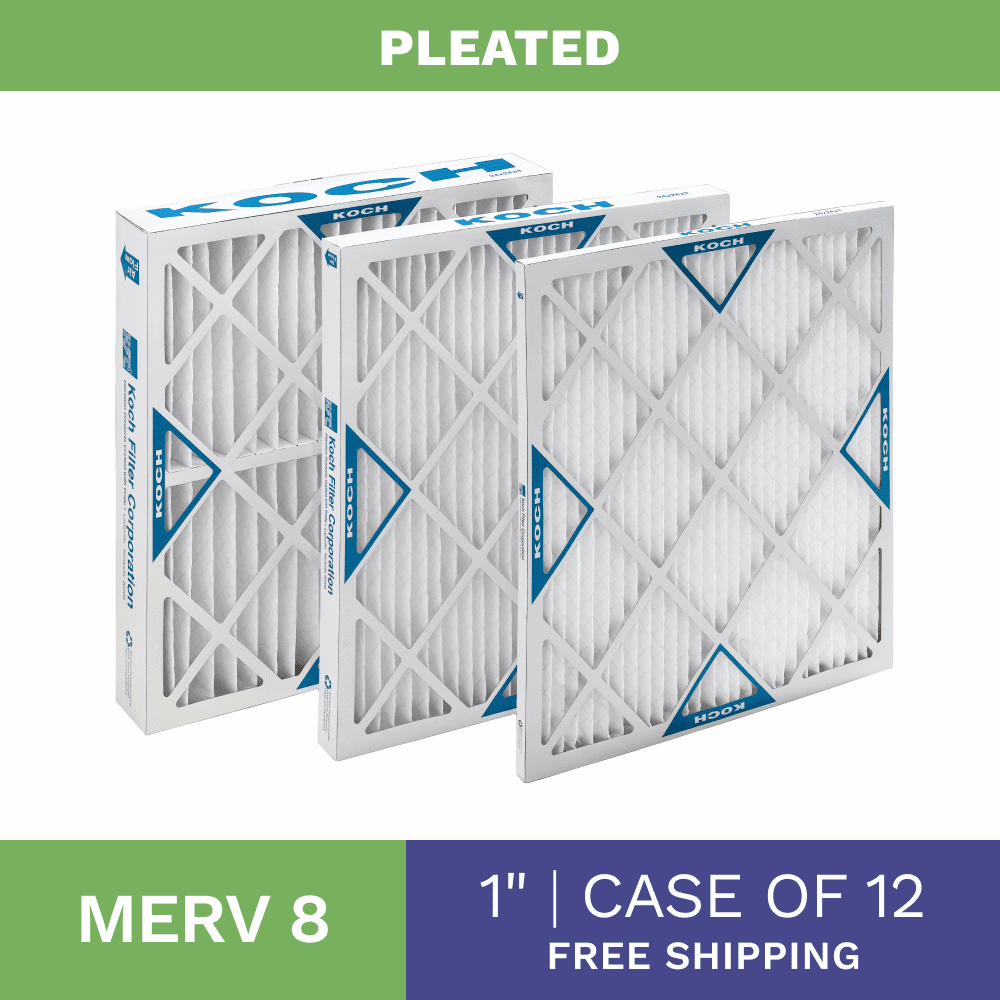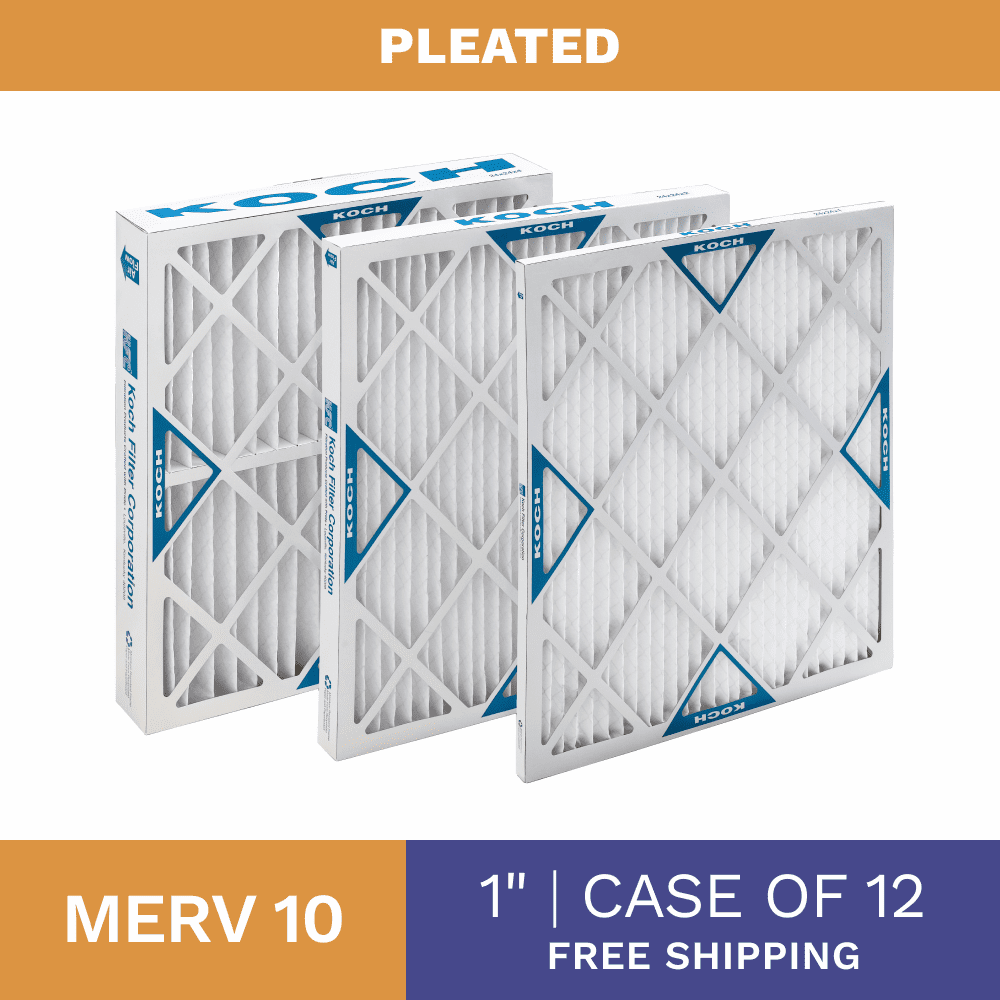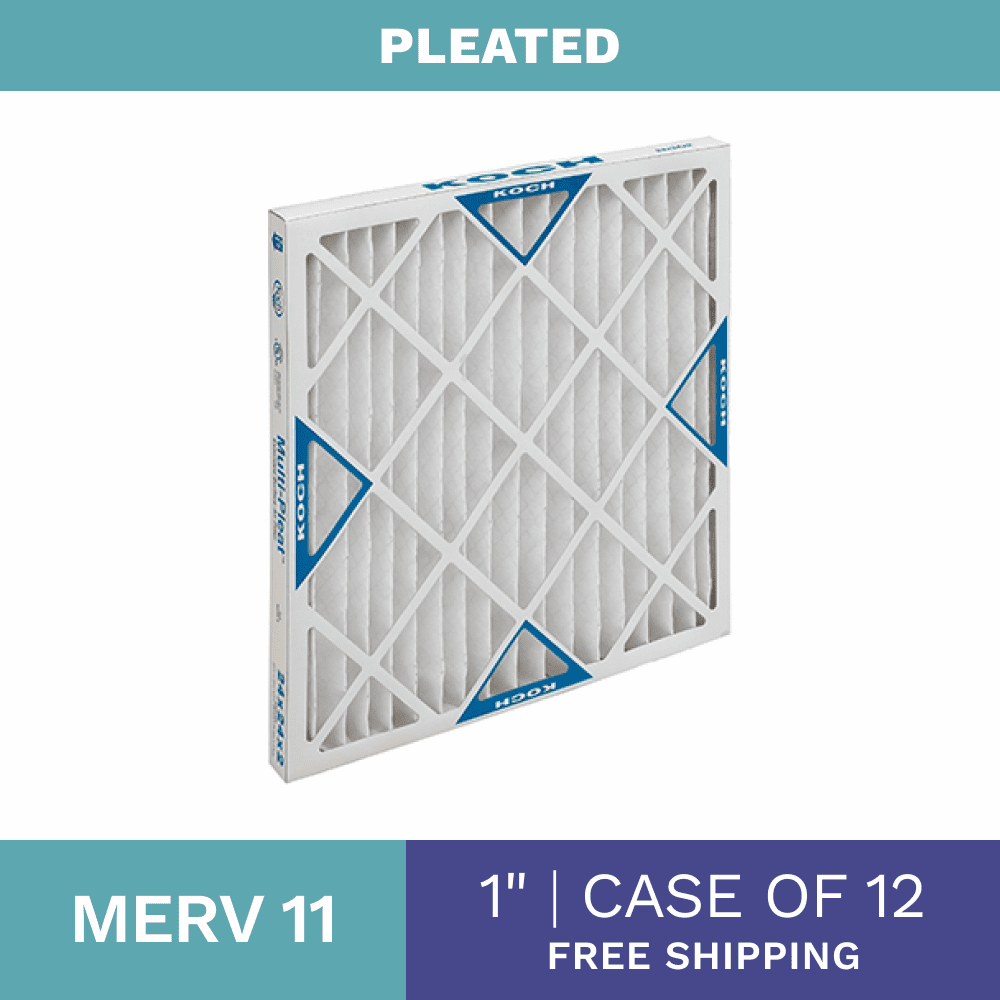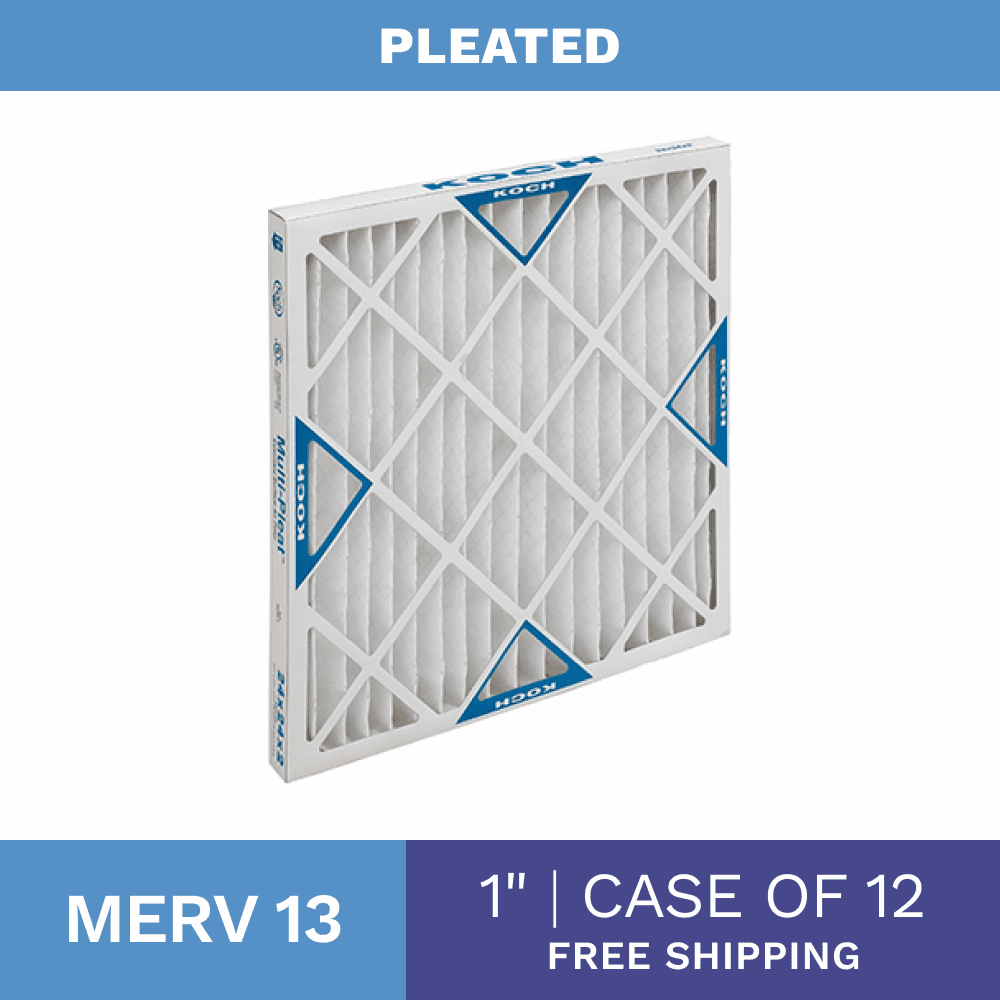
Choosing the right air filter improves air quality, reducing allergens, dust, and other airborne particles that affect your health and comfort. However, deciding which is best for your needs can be confusing with so many different types available.
In this guide, we’ll break down three popular types of air filters: fiberglass, polyester, and pleated air filters.
We’ll explore each’s unique qualities, pros, and cons, and help you decide which best suits your needs.
Fiberglass Filters
Fiberglass filters are the most common and affordable air filters available. They are made from spun glass fibers or non-woven fiberglass media, with a flimsy cardboard frame that gives them a flat, panel-like appearance.

These filters have a low MERV (Minimum Efficiency Reporting Value) rating, between 2 and 4. A low MERV rating means these filters don’t capture smaller particles such as pollen, bacteria, and viruses.
However, they have minimal resistance to airflow. A new fiberglass filter has an airflow resistance of 0.07 inches wg when air flows at 300 feet per minute, while an old fiberglass filter has a resistance of 0.50 inches wg
Fiberglass filters have an average arrestance of 65% to 75%. Arrestance measures an air filter’s ability to capture synthetic dust. Synthetic dust includes ASHRAE and A2 fine test dust, which simulate real-world dust conditions to evaluate filter performance.
Fiberglass filters are used in residential settings where basic filtration is needed to protect HVAC equipment from large dust and debris particles.
Fiberglass filters are perfect for homeowners and businesses looking for a cost-effective solution to maintaining their HVAC systems. They are ideal for residences or non-critical commercial spaces.
The fiberglass filter’s low resistance to airflow helps maintain efficient system performance, reducing strain on HVAC equipment and potentially lowering energy costs.
Choose fiberglass filters if you need a budget-friendly option for basic air filtration. They will protect your equipment and maintain good airflow without requiring high-efficiency air purification.
Benefits of Fibreglass Filters
- Cost-Effective: These filters are the most affordable option, typically costing between $5 and $10 per piece for basic sizes.
- Minimal Airflow Resistance: These filters offer low resistance to airflow, meaning they do not significantly load HVAC systems. This helps maintain HVAC system efficiency and reduces energy consumption.
- Simple Installation and Replacement: These filters are lightweight and have a flat, panel-like design, making them easy to install and replace.
- High-Temperature Operation: These disposable air filters can operate at temperatures up to 300°F, making them suitable for hot climates, kitchens, etc. However, please note that these filters are not designed for high-temperature filtration.
Considerations when choosing Fibreglass Filters
- Low Filtration Efficiency: Fiberglass filters have a low MERV rating of 2 to 4, which means they capture larger particles (more than 3.0 microns), such as textile and carpet fibers. They are ineffective at capturing smaller particles like pollen, mold spores, bacteria, and viruses.
- Shorter Lifespan: These filters must be replaced more frequently every 30 days.
- Low Dust Holding Capacity: The panel-style media used in fiberglass filters has a smaller surface area for trapping and holding debris, resulting in a lower dust-holding capacity.
- Environmental Impact: The materials used to make fiberglass filters cannot be recycled or biodegradable.
Polyester Filters
Polyester filters are made from high-quality polyester media. The polyester fibers are bonded to create an interlocking pattern, which minimizes surface loading and prevents fiber break-off.
Polyester filters are more durable and perform better than fiberglass filters.
These filters are reinforced with a heavy chipboard frame and held with a synthetic resin hot melt or a fast-setting cold glue-water-based adhesive. They also have bottle capping for extra support and durability.

Polyester filters have a higher MERV rating than fiberglass filters, ranging from 4 to 7. This allows them to capture particles such as mold spores, pollen, dust, and fibers more effectively.
Polyester filters offer slightly higher airflow resistance, with initial resistance at 300 FPM being .016 inch wg and final resistance at .50 inch wg. They have an average arrestance of 75 to 85%, effectively removing synthetic dust from the air.
Polyester filters are ideal for residential and light commercial settings where better air quality is needed. They work well in environments with moderate dust levels and are great for individuals with mild allergies.
Benefits of Polyester Filters
- Durability: Polyester filters are made from 100% polyester monofilament yarn and are more durable than fiberglass filters. They are more robust and can withstand higher airflow rates and pressure drops without collapsing.
- Better Filtration Efficiency: These filters have a higher MERV rating (4 to 8) and can capture smaller particles such as mold spores, pollen, dust, and fibers.
- High-Temperature Resistance: Polyester filters can withstand temperatures up to 200°F.
- Better Dust Holding Capacity: Their interlocking design and quality polyester material help them catch and hold more dust and debris, improving their filtration and making them last longer.
Considerations when choosing Polyester Filters
- Moderate Cost: Polyester filters are more expensive than fiberglass filters but less costly than pleated filters, typically costing between $6 and $11 per piece for standard sizes.
- Moderate Resistance: These filters have slightly higher airflow resistance than fiberglass filters. This can reduce HVAC efficiency and increase energy costs.
- Environmental Impact: Like fiberglass filters, polyester filters are not biodegradable and cannot be recycled.
- Maintenance Frequency: Although more durable, polyester filters require regular maintenance and replacement, typically every 30-60 days.
Pleated Filters
Pleated air filters provide superior air filtration compared to fiberglass and polyester filters. They are made from pliable materials such as polyester, cotton, or paper, folded into an accordion-like shape. These folds, or pleats, increase the filter's surface area, allowing it to capture more particles.
Pleated MERV 8 filters, the entry-level pleated filter, are the most common residential filter recommended in the U.S.

These air filters are made of sturdy cardboard. They are reinforced with an expanded metal backing and protective sealing, enhancing durability and stability.
Pleated filters usually have a MERV rating between 8 and 13 in a residential setting. They can trap tiny particles like lint, dust mites, mold spores, pollen, pet dander, fine dust, and smoke. A MERV 13 pleated air filter can even filter viruses and bacteria.
Pleated air filters have an initial resistance at 300 FPM of .014 inch wg and a final resistance of 1.0 inch wg. They have an average arrestance of up to 90%, making them highly effective at improving air quality.
Pleated filters are ideal for residential and commercial environments that require high air quality standards. They are suitable for individuals with allergies, asthma, or other respiratory conditions and settings with higher dust levels or specific air quality requirements.
Benefits of Pleated Filters
- Superior Filtration: Pleated filters have a higher MERV rating, enabling them to capture smaller particles ranging from 1.0 to 3.0 microns, such as pollen, mold spores, and dust mites. This greatly enhances indoor air quality by filtering out more contaminants.
- High Dust Holding Capacity: The pleated design increases the filter's surface area, allowing it to trap more particles. This enhances filtration efficiency and lets the filter hold more dust and debris before needing replacement.
- Extended Lifespan: The pleated design provides more dirt-holding capacity, enabling the filters to last up to 90 days.
- Robust Construction: These filters are built to be sturdy and durable. They are made with high-quality synthetic media and a die-cut solid frame, which remains reliable even in high humidity conditions.
- Temperature Resistance: Pleated filters can withstand temperatures up to 200°F.
Considerations when choosing Pleated Filters
- Higher Initial Cost: Pleated filters are more expensive than fiberglass and polyester filters, typically costing between $8 and $25 per piece.
- Increased Airflow Resistance: The dense pleated design causes higher airflow resistance. This potentially leads to increased energy consumption as the HVAC system works harder to maintain airflow.
- Potential for Overkill: In environments with relatively clean air or minimal air quality concerns, the advanced filtration capabilities of pleated filters are unnecessary. Using these filters in such settings leads to increased costs without significant benefits.
- Environmental Impact: Like other synthetic filters, pleated filters are not biodegradable and contribute to environmental waste. Proper disposal is necessary to minimize their ecological footprint.
| Fibreglass | Polyester | Pleated | |
|---|---|---|---|
| MERV Rating | 2-4 | 4-8 | 8-13 |
| Minimum Particle Size Trapped | >10 microns | 3-10 microns | 1-3 microns |
| Typical Particles Trapped | Dust, lint, textile and carpet fibers | Dust, lint, textile, and carpet fibers | Pet dander, mold spores, pollen, fine dust, smoke, viruses, bacteria |
| Resistance to Airflow | Low | Moderate | Higher |
| Filter Lifespan | Up to 30 days | Up to 60 days | Up to 90 days |
| Cost of the filter | $5-$10 per piece | $6-$11 per piece | $8-$25 per piece |
| Impact on HVAC Energy Consumption | Low | Moderate | Higher |
| Availability in Different Sizes | Yes | Yes | Yes |
| Available in Custom Size Air Filters | Yes | Yes | Yes |
Deciding Between Polyester, Fibreglass, and Pleated: Factors to Consider
Choosing the right air filter can feel overwhelming, but it all starts with understanding the pollution levels in your area.
Suppose you live in an area with high pollution (AQI over 50). In that case, you'll need a filter with a MERV rating of 8-13 to optimize indoor air quality. On the other hand, if the pollution level is below 50 AQI, a filter with a MERV rating of 2-4 will be sufficient.
However, the decision also depends on specific use cases, which can vary widely based on individual needs and circumstances:
- Basic Residential Use: Areas with low pollution and no specific air quality concerns can utilize fiberglass filters as a cost-effective option.
- Residential Use in High-Pollution Areas: Residents in high-pollution areas should use pleated filters with a MERV rating of 10-13.
- Homes with Pets: Households with pets benefit from pleated filters that capture pet dander and hair.
- Allergy-prone Individuals: Individuals with asthma and other respiratory issues benefit from pleated filters, which trap allergens such as pollen, mold spores, and dust mites.
- Industrial Environments: Workplaces with high dust and particulate matter levels require pleated filters to protect workers’ health and HVAC systems.
- Seasonal Use: Environments with fluctuating air quality, like during pollen season in spring or increased dust in the summer, can benefit from polyester filters, which are perfect for seasonal use.
Final Thoughts on Choosing Filters
Choosing the right air filter is essential for maintaining a healthy indoor environment, whether at home or in a commercial setting. With various types available, it is crucial to compare and understand the differences between fiberglass, polyester, and pleated filters.
Each filter type offers unique benefits and considerations, making them suitable for different situations. Understanding these differences helps you make an informed decision that enhances indoor air quality and meets your needs.
Choosing the right air filter is essential for maintaining a healthy indoor environment. With various types available, it is crucial to understand the differences between fiberglass, polyester, and pleated filters.
Each filter type has pros and cons. Understanding these differences can help you make an informed decision that enhances indoor air quality and meets your needs.
We are here to help you, so please call us or send us a note, and we'll help you find the best filter for your situation.
For more information and the best air filters, check out AC Filters 4 Less.



